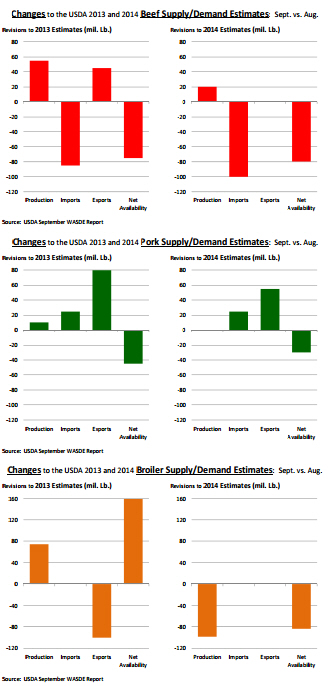



CME: Changes to Livestock Supply Estimates for 2013 and 2014
US - The latest USDA WASDE update contained a number of important changes to estimates of grain and livestock supplies for the remainder of 2013 and 2014, write Steve Meyer and Len Steiner.On the grain front, USDA surprised the market by revising up its estimates for corn yields. Prior to the report analysts had pegged yields to be a little under 154 bushels per acre, about half a bushel lower than the USDA August estimate. In its latest report, USDA put corn yields at 155.3 bu/acre, almost 1 bushel higher than its previous forecast. The latest yield numbers incorporate objective data from field reports and thus are seen as more credible than previous modeled estimates. The revision added about 80 million bushels to the estimate for corn production this year. Total US corn production for 2013 is now pegged at 13.843 billion bushels, some 3 billion bushels larger than a year ago. To put this in context, consider that feed/res use last year was about 4.475 billion bushels. Some of the extra corn will go into livestock production. Ethanol output also is expected to increase given improving ethanol margins and the need to hit mandated use levels.
In the coming months, demand concerns will likely continue to weigh on feed prices. USDA also made a number of changes to its estimates for beef, pork and poultry supply/demand. The charts below summarise the changes made from the August estimates.
Keep in mind, these are not changes from a year ago, they are the revisions to the last estimates. Probably the most important number to consider when you look at the charts is the net availability number. This is basically the supply of beef, pork and broilers that will need to be absorbed in the domestic market. This is often called consumption but the reality is that no-one knows how much gets consumed and how much either is lost between the packer and the time it reaches the consumer (shrink) and how much is actually left on the plate or put in the fridge to be thrown out the next day.
USDA reduced net availability of beef for 2013 by 75 million pounds (-0.3%) and by 80 million for 2014. As we noted in our report a couple of days ago, the main driver for the changes is the slower pace of beef imports. USDA still expects beef imports at 2.640 billion pounds in 2014, a forecast that requires a notable increase in US beef imports from Australia and Canada. There is serious concerns whether that will be possible given demand from other markets and the notable reduction in the beef cow herd in Canada. USDA revised up its pork export number, which is consistent with the current trend in the market.
Pork exports were also revised up for next year. As a result, domestic pork availability was lowered by 0.2% for both 2013 and 2014. It is important to recognize that pork supplies in the domestic market in 2014 are still forecasted to be up 3% vs. 2013 levels and up 5.8% compared to 2012.









